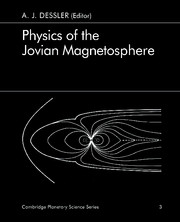Book contents
- Frontmatter
- Contents
- List of tables
- List of contributors
- Foreword
- Preface
- 1 Jupiter's magnetic field and magnetosphere
- 2 Ionosphere
- 3 The low-energy plasma in the Jovian magnetosphere
- 4 Low-energy particle population
- 5 High-energy particles
- 6 Spectrophotometric studies of the Io torus
- 7 Phenomenology of magnetospheric radio emissions
- 8 Plasma waves in the Jovian magnetosphere
- 9 Theories of radio emissions and plasma waves
- 10 Magnetospheric models
- 11 Plasma distribution and flow
- 12 Microscopic plasma processes in the Jovian magnetosphere
- Appendix A Symbols and acronyms
- Appendix B Coordinate systems
- Appendix C Jupiter and Io: selected physical parameters
- References
- Index
Foreword
Published online by Cambridge University Press: 27 October 2009
- Frontmatter
- Contents
- List of tables
- List of contributors
- Foreword
- Preface
- 1 Jupiter's magnetic field and magnetosphere
- 2 Ionosphere
- 3 The low-energy plasma in the Jovian magnetosphere
- 4 Low-energy particle population
- 5 High-energy particles
- 6 Spectrophotometric studies of the Io torus
- 7 Phenomenology of magnetospheric radio emissions
- 8 Plasma waves in the Jovian magnetosphere
- 9 Theories of radio emissions and plasma waves
- 10 Magnetospheric models
- 11 Plasma distribution and flow
- 12 Microscopic plasma processes in the Jovian magnetosphere
- Appendix A Symbols and acronyms
- Appendix B Coordinate systems
- Appendix C Jupiter and Io: selected physical parameters
- References
- Index
Summary
During the early 1960s the dominant emphasis of the space program of the United States was on manned space flight, looking toward landings on the moon and the detailed investigation thereof. Parallel with these activities, but at a much lower level of emphasis, was the development of a national program of planetary exploration. The nearby terrestrial planets Venus and Mars were the most readily accessible. Also, interest in search for extraterrestrial life on Mars provided a strong motivation for landing on its surface an elaborate device called an automated biological laboratory. The mission for accomplishing this was called Voyager, a name that was later changed to Viking. Still later, the name Voyager was adopted for an altogether different planetary mission.
The development of a national program of planetary exploration had many sources and many aspects. But to a very considerable extent, all of these aspects came into focus most clearly within the Space Science Board (SSB) of the National Academy of Sciences and more specifically within the National Aeronautics and Space Administration's Lunar and Planetary Missions Board (LPMB), created in early 1967 under the chairmanship of John W. Findlay of the National Radio Astronomy Observatory, with Homer E. Newell, John E. Naugle, Donald P. Hearth, Oran Nicks, and Robert Kraemer as the principal NASA participants. The minutes of the LPMB over the period 1967–70 reflect intensive and comprehensive consideration of every subsequently conducted lunar and planetary mission, as well as several that have not yet been conducted.
- Type
- Chapter
- Information
- Physics of the Jovian Magnetosphere , pp. xi - xiiPublisher: Cambridge University PressPrint publication year: 1983



